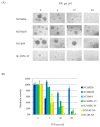Pediatric and Adult High-Grade Glioma Stem Cell Culture Models Are Permissive to Lytic Infection with Parvovirus H-1
- PMID: 27213425
- PMCID: PMC4885093
- DOI: 10.3390/v8050138
Pediatric and Adult High-Grade Glioma Stem Cell Culture Models Are Permissive to Lytic Infection with Parvovirus H-1
Abstract
Combining virus-induced cytotoxic and immunotherapeutic effects, oncolytic virotherapy represents a promising therapeutic approach for high-grade glioma (HGG). A clinical trial has recently provided evidence for the clinical safety of the oncolytic parvovirus H-1 (H-1PV) in adult glioblastoma relapse patients. The present study assesses the efficacy of H-1PV in eliminating HGG initiating cells. H-1PV was able to enter and to transduce all HGG neurosphere culture models (n = 6), including cultures derived from adult glioblastoma, pediatric glioblastoma, and diffuse intrinsic pontine glioma. Cytotoxic effects induced by the virus have been observed in all HGG neurospheres at half maximal inhibitory concentration (IC50) doses of input virus between 1 and 10 plaque forming units per cell. H-1PV infection at this dose range was able to prevent tumorigenicity of NCH421k glioblastoma multiforme (GBM) "stem-like" cells in NOD/SCID mice. Interestingly NCH421R, an isogenic subclone with equal capacity of xenograft formation, but resistant to H-1PV infection could be isolated from the parental NCH421k culture. To reveal changes in gene expression associated with H-1PV resistance we performed a comparative gene expression analysis in these subclones. Several dysregulated genes encoding receptor proteins, endocytosis factors or regulators innate antiviral responses were identified and represent intriguing candidates for to further study molecular mechanisms of H-1PV resistance.
Keywords: DIPG; H-1PV; glioma stem-like cells; high-grade glioma; oncolytic virus; parvovirus H-1; pediatric glioblastoma; tumor initiating cells.
Figures










Similar articles
-
Immunotherapeutic Potential of Oncolytic H-1 Parvovirus: Hints of Glioblastoma Microenvironment Conversion towards Immunogenicity.Viruses. 2017 Dec 15;9(12):382. doi: 10.3390/v9120382. Viruses. 2017. PMID: 29244745 Free PMC article.
-
Improved killing of human high-grade glioma cells by combining ionizing radiation with oncolytic parvovirus H-1 infection.J Biomed Biotechnol. 2010;2010:350748. doi: 10.1155/2010/350748. Epub 2010 Mar 7. J Biomed Biotechnol. 2010. PMID: 20224643 Free PMC article.
-
Therapeutic implications of the enhanced short and long-term cytotoxicity of radiation treatment followed by oncolytic parvovirus H-1 infection in high-grade glioma cells.Bioeng Bugs. 2010 Nov-Dec;1(6):429-33. doi: 10.4161/bbug.1.6.12943. Bioeng Bugs. 2010. PMID: 21468212 Free PMC article.
-
H-1 Parvovirus as a Cancer-Killing Agent: Past, Present, and Future.Viruses. 2019 Jun 18;11(6):562. doi: 10.3390/v11060562. Viruses. 2019. PMID: 31216641 Free PMC article. Review.
-
[Oncolytic parvoviruses. A new approaches for cancer therapy].Vestn Ross Akad Med Nauk. 2012;(2):42-7. Vestn Ross Akad Med Nauk. 2012. PMID: 22642177 Review. Russian.
Cited by
-
Zika Virus Targets Glioblastoma Stem Cells through a SOX2-Integrin αvβ5 Axis.Cell Stem Cell. 2020 Feb 6;26(2):187-204.e10. doi: 10.1016/j.stem.2019.11.016. Epub 2020 Jan 16. Cell Stem Cell. 2020. PMID: 31956038 Free PMC article.
-
Tumour immune landscape of paediatric high-grade gliomas.Brain. 2021 Oct 22;144(9):2594-2609. doi: 10.1093/brain/awab155. Brain. 2021. PMID: 33856022 Free PMC article. Review.
-
Novel Pharmacological Treatment Options in Pediatric Glioblastoma-A Systematic Review.Cancers (Basel). 2022 Jun 6;14(11):2814. doi: 10.3390/cancers14112814. Cancers (Basel). 2022. PMID: 35681794 Free PMC article. Review.
-
Oncolytic Viruses in Combination Therapeutic Approaches with Epigenetic Modulators: Past, Present, and Future Perspectives.Cancers (Basel). 2021 Jun 2;13(11):2761. doi: 10.3390/cancers13112761. Cancers (Basel). 2021. PMID: 34199429 Free PMC article. Review.
-
Therapeutic avenues for targeting treatment challenges of diffuse midline gliomas.Neoplasia. 2023 Jun;40:100899. doi: 10.1016/j.neo.2023.100899. Epub 2023 Apr 6. Neoplasia. 2023. PMID: 37030112 Free PMC article. Review.
References
Publication types
MeSH terms
LinkOut - more resources
Full Text Sources
Other Literature Sources
Medical

